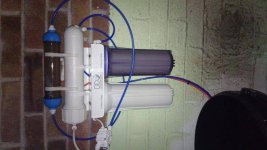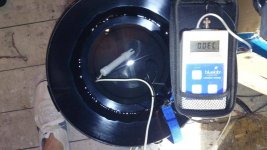OK rob, you do have a calcium and a magnesium def. The chlorosis and spotting on the lower leaves is the mag being translocated to new growth.
Calcium can not be translocated from old growth because it is locked in cell walls. It manifests itself in the curling of the new growth. the edges of the new leaves get an insufficient amount of Ca and stop growing and the middle of the leaf continues to grow a bit causing the curl. it's not caused by too much N, though N helps the middle grow more and curl more.
Cal and mag get locked out at low pH. I would never run coco at 5.5 as some suggested. but you're at 6 to 6.3 so that's not it. I'd keep it from 5.8 to 6.2. Most likely you have an antagonism going because of all the junk in your nutes and whatever salts are getting past your ro filter.
I'd be concerned about whatever is getting by your ro filter and making your water start at 150. Me, i'd skip the ro water and skip the calmag, and just give basic nutes with a pk boost like koolbloom in flower.
edit- Sometimes you can get a buildup of nutes and salts in your coco and will drop the pH down in the rootzone locking out ca and mag. Can be fixed with a good flush with light nutes.
Calcium can not be translocated from old growth because it is locked in cell walls. It manifests itself in the curling of the new growth. the edges of the new leaves get an insufficient amount of Ca and stop growing and the middle of the leaf continues to grow a bit causing the curl. it's not caused by too much N, though N helps the middle grow more and curl more.
Cal and mag get locked out at low pH. I would never run coco at 5.5 as some suggested. but you're at 6 to 6.3 so that's not it. I'd keep it from 5.8 to 6.2. Most likely you have an antagonism going because of all the junk in your nutes and whatever salts are getting past your ro filter.
I'd be concerned about whatever is getting by your ro filter and making your water start at 150. Me, i'd skip the ro water and skip the calmag, and just give basic nutes with a pk boost like koolbloom in flower.
edit- Sometimes you can get a buildup of nutes and salts in your coco and will drop the pH down in the rootzone locking out ca and mag. Can be fixed with a good flush with light nutes.
Last edited:







